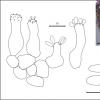
09-07-2013 08:40
Marja PennanenHello again,after finding this leaf, I tried to fi

04-07-2013 16:01
Stefan BlaserHello everybody My last riddle was solved so fast

08-07-2013 18:35
Nina FilippovaGood evening.The litter of cottongrass (Er. vagina

07-07-2013 23:34
 Alessio Pierotti
Alessio Pierotti
For the revisions of the exsiccata of fungi and li

07-07-2013 06:48
Nina FilippovaBoth these species are rare, but several times col
A carnivorous plant, sundew (Drosera anglica, D. rotundifolia) may have some special biochemical composition and accordingly adapted to it fungal community. I collected four morpho-species from this plant so far. Though its leaves are thick and there are many of them in the litter, they were. All collected species were growing at flowering shoots and at fruits. Probably, digestive enzymes in leaf drops ("due") could be repellent to fungi.
One common enough here species is a Mycosphaerella. The perithecia are very tiny, up to 100 mk and barely visible. But there are mature asci and two-celled hyaline spores inside, in reward for the tedious work with such a small objects. (#4204 - https://www.cubby.com/pl/%234204/_6eca9336e9e841359e9ced422c8bcf11)
Some relative of Bortytis was spotted after the short incubation in a wet chamber.(#4201 - https://www.cubby.com/pl/%234201/_ca45a85a098d43a5b7e6de51328c4cac)
Another anamorphic species with surprising look was revealed at the scale of a fruit. Clavate conidiogenous cells bear at its tips several ellipsoid conidia. (#4205 - https://www.cubby.com/pl/%234205/_a06c63f7ce7d4c46b533d8d9769c6919)
The last morpho-species is again anamorphic. Small perithecioid structures were spotted in upper part of a stem. They filled with drop-shaped conidiogenous cells, from upper narrowed part of those arise ellipsoid conidia. And look at the photo: obviously, this dinosaur threatens to our fungus ). (#4207 - https://www.cubby.com/pl/%234207/_fd8ac1df758742e2baa9e219b70a88ee)?





